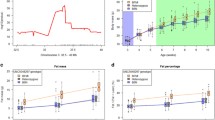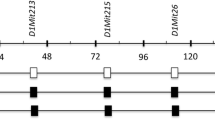Abstract
In a previous study we characterized the B6.CAST-(D2Mit329-D2Mit457)N(6) (B62D) congenic strain, which possesses CAST/EiJ (CAST) chromosome 2 donor alleles from 74 to 180 Mbp on a C57BL6/J (B6) background. This strain exhibited significant decreases in body weight and adiposity attributable to the weight gain 2 (Wg2) quantitative trait locus (QTL). To refine the location of Wg2, we used a two-stage genetic dissection strategy consisting of a B62D × B6 backcross, which mapped Wg2 to the proximal portion of the B62D donor region, followed by the development of seven overlapping subcongenic F2 intercrosses targeting the Wg2 genomic interval. Surprisingly, five of the seven intercrosses displayed significant differences, dependent on genotype, in body weight and/or fat pad mass. These effects were the result of at least four independent QTLs that were named Wg2a, b, c, and d. In contrast to the lean and low body weight phenotype of the B62D parental strain, mice homozygous for CAST congenic alleles (cast/cast) at Wg2a were significantly heavier at 6 and 9 weeks of age, while cast/cast mice at Wg2c had higher levels of total fat. Consistent with the prior observed effects of Wg2, cast/cast mice at Wg2b displayed significant decreases in 6- and 9-week body weight as well as a decrease in total fat pad mass. All of the QTLs had additive effects on body composition except Wg2d, which displayed underdominance for total fat mass. Significant differences in weight and adiposity were also observed in genetically identical b6/b6 homozygous mice across the panel of subcongenics, suggesting either maternal or paternal contributions to body composition. These data represent a significant advancement toward the identification of mouse chromosome 2 growth and obesity quantitative trait genes.



Similar content being viewed by others
References
Baskin ML, Ard J, Franklin F, Allison DB (2005) Prevalence of obesity in the United States. Obes Rev 6:5–7
Bradford GE, Famula TR (1984) Evidence for a major gene for rapid postweaning growth in mice. Genet Res 44:293–308
Broman KW, Wu H, Sen S, Churchill GA (2003) R/qtl: QTL mapping in experimental crosses. Bioinformatics 19:889–890
Churchill GA, Doerge RW (1994) Empirical threshold values for quantitative trait mapping. Genetics 138:963–971
Diament AL, Warden CH (2004) Multiple linked mouse chromosome 7 loci influence body fat mass. Int J Obes Relat Metab Disord 28:199–210
Diament AL, Farahani P, Chiu S, Fisler J, Warden CH (2004) A novel mouse Chromosome 2 congenic strain with obesity phenotypes. Mamm Genome 15:452–459
Dietrich WF, Miller J, Steen R, Merchant MA, Damron-Boles D, et al. (1996) A comprehensive genetic map of the mouse genome. Nature 380:149–152
Edderkaoui B, Baylink DJ, Beamer WG, Wergedal JE, Dunn NR, et al. (2006) Multiple genetic loci from CAST/EiJ chromosome 1 affect vBMD either positively or negatively in a C57BL/6J background. J Bone Miner Res 21:97–104
Edwards D, Berry JJ (1987) The efficiency of simulation-based multiple comparisons. Biometrics 43:913–928
Estrada-Smith D, Collins AR, Wang X, Crockett C, Castellani L, et al. (2006) Impact of chromosome 2 obesity loci on cardiovascular complications of insulin resistance in LDL receptor-deficient C57BL/6 mice. Diabetes 55:2265–2271
Farber CR, Medrano JF (2007) Fine mapping reveals sex bias in quantitative trait loci affecting growth, skeletal size and obesity-related traits on mouse chromosomes 2 and 11. Genetics 175:349–360
Farber CR, Corva PM, Medrano JF (2006) Genome-wide isolation of growth and obesity QTL using mouse speed congenic strains. BMC Genomics 7:102
Ghazalpour A, Wang X, Lusis AJ, Mehrabian M (2006) Complex inheritance of the 5-lipoxygenase locus influencing atherosclerosis in mice. Genetics 173:943–951
Horvat S, Medrano JF (2001) Lack of Socs2 expression causes the high-growth phenotype in mice. Genomics 72:209–212
Jarvis JP, Kenney-Hunt J, Ehrich TH, Pletscher LS, Semenkovich CF, et al. (2005) Maternal genotype affects adult offspring lipid, obesity, and diabetes phenotypes in LGXSM recombinant inbred strains. J Lipid Res 46:1692–1702
Jerez-Timaure NC, Kearney F, Simpson EB, Eisen EJ, Pomp D (2004) Characterization of QTL with major effects on fatness and growth on mouse chromosome 2. Obes Res 12:1408–1420
Jerez-Timaure NC, Eisen EJ, Pomp D (2005) Fine mapping of a QTL region with large effects on growth and fatness on mouse chromosome 2. Physiol Genomics 21:411–422
Karolchik D, Baertsch R, Diekhans M, Furey TS, Hinrichs A, et al. (2003) The UCSC Genome Browser Database. Nucleic Acids Res 31:51–54
Lander ES, Botstein D (1989) Mapping mendelian factors underlying quantitative traits using RFLP linkage maps. Genetics 121:185–199
Lyons PA, Hancock WW, Denny P, Lord CJ, Hill NJ, et al. (2000) The NOD Idd9 genetic interval influences the pathogenicity of insulitis and contains molecular variants of Cd30, Tnfr2, and Cd137. Immunity 13:107–115
Maes HH, Neale MC, Eaves LJ (1997) Genetic and environmental factors in relative body weight and human adiposity. Behav Genet 27:325–351
Pomerleau DP, Bagley RJ, Serreze DV, Mathews CE, Leiter EH (2005) Major histocompatibility complex-linked diabetes susceptibility in NOD/Lt mice: subcongenic analysis localizes a component of Idd16 at the H2-D end of the diabetogenic H2(g7) complex. Diabetes 54:1603–1606
Rozen S, Skaletsky H (2000) Primer3 on the WWW for general users and for biologist programmers. Methods Mol Biol 132:365–386
Serreze DV, Bridgett M, Chapman HD, Chen E, Richard SD, et al. (1998) Subcongenic analysis of the Idd13 locus in NOD/Lt mice: evidence for several susceptibility genes including a possible diabetogenic role for beta 2-microglobulin. J Immunol 160:1472–1478
Silver LM (1995) Mouse Genetics: Concepts and Applications (Oxford: Oxford University Press)
Stylianou IM, Korstanje R, Li R, Sheehan S, Paigen B, et al. (2006) Quantitative trait locus analysis for obesity reveals multiple networks of interacting loci. Mamm Genome 17:22–36
Wang X, Gargalovic P, Wong J, Gu JL, Wu X, et al. (2004) Hyplip2, a new gene for combined hyperlipidemia and increased atherosclerosis. Arterioscler Thromb Vasc Biol 24:1928–1934
Warden CH, Stone S, Chiu S, Diament AL, Corva P, et al. (2004) Identification of a congenic mouse line with obesity and body length phenotypes. Mamm Genome 15:460–471
Wolf JB, Vaughn TT, Pletscher LS, Cheverud JM (2002) Contribution of maternal effect QTL to genetic architecture of early growth in mice. Heredity 89:300–310
Wong ML, Islas-Trejo A, Medrano JF (2002) Structural characterization of the mouse high growth deletion and discovery of a novel fusion transcript between suppressor of cytokine signaling-2 (Socs-2) and viral encoded semaphorin receptor (Plexin C1). Gene 299:153–163
Acknowledgments
The authors thank Vince De Vera for mouse care and Alma Islas-Trejo, Kerri Morimoto, Gonzalo Rincon, Ricardo Verdugo, Karina Guevara, James Chitwood, Lee Nguyen, and Anna Chen for assistance with mouse phenotyping. This work was supported by the National Research Initiative of the USDA Cooperative State Research, Education and Extension Service, grant number 2005-35205-15453. C.R. Farber was supported by an Austin Eugene Lyons fellowship.
Author information
Authors and Affiliations
Corresponding author
Rights and permissions
About this article
Cite this article
Farber, C.R., Medrano, J.F. Dissection of a genetically complex cluster of growth and obesity QTLs on mouse chromosome 2 using subcongenic intercrosses. Mamm Genome 18, 635–645 (2007). https://doi.org/10.1007/s00335-007-9046-0
Received:
Accepted:
Published:
Issue Date:
DOI: https://doi.org/10.1007/s00335-007-9046-0




